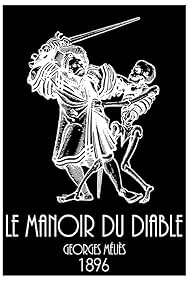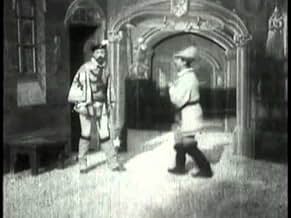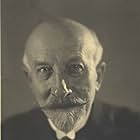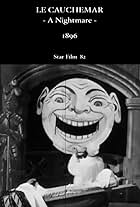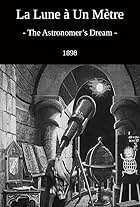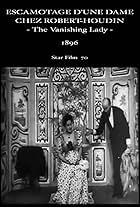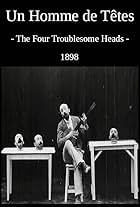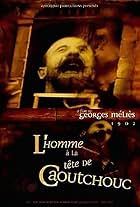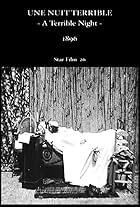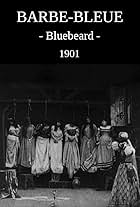IMDb RATING
6.7/10
4.2K
YOUR RATING
With the help of a magic cauldron, Mephistopheles conjures up a variety of supernatural characters.With the help of a magic cauldron, Mephistopheles conjures up a variety of supernatural characters.With the help of a magic cauldron, Mephistopheles conjures up a variety of supernatural characters.
- Director
- Writer
- Stars
Jehanne d'Alcy
- Young woman
- (as Jeanne d'Alcy)
Jules-Eugène Legris
- Mephistopheles
- (unconfirmed)
- Director
- Writer
- All cast & crew
- Production, box office & more at IMDbPro
Storyline
Did you know
- TriviaFilm historians argue that this is the first film depiction of a vampire. While director and actor credited his character as Mephistopheles, a legendary demon, many horror elements associated with vampires exist in the film and are exhibited by the character. These include the transformation from bat to human form, conjuring a harem of demonic brides, apparent mesmeric control, and the ability to conjure humans and creatures to serve him. Many of vampire stereotypes featured here remained tropes in early films about vampires.
- GoofsAt around 00:03:00, while the ghosts are dancing in a circle, one of the ghosts makes contact with the wall and the entire set shakes considerably.
- ConnectionsFeatured in Horror Hotel: Nosferatu (2015)
Featured review
I'm not interested in retroactively assigning early films to the horror genre, as others seem to desire by claiming this film, "Le manoir du diable", as some sort of first horror film or to misunderstand the bat transformation to devil character here to be a vampire. Rather, this is another trick film, which Méliès made many of. Mephistopheles is in quite a few of these, of which this is probably the first. Mephistopheles is the director-magician's surrogate, allowing a slight narrative construction around the attraction of substitution-splices (a.k.a. stop substitutions), as the devil terrorizes a lord/cavalier with various appearances, disappearances and substitutions. By the way, I'm quite sure that Méliès plays the Faust-type lord/cavalier character and not Mephistopheles, despite several sources stating otherwise. Thus, Méliès plays the victim to the magic perpetrated by himself as the film's director and editor.
For a film of 1896, this is a rather elaborate fiction subject and production. Most films at this time were actualities of ordinary events, popularized by the Lumiére Company. The only studio had been the "Black Maria" shack, which provided a black background for every production, in addition to the few props the Edison Company occasionally employed. Soon, Méliès would create the first decent movie studio, but for this film, he at least created a makeshift, painted cardboard set in the open air (see the shadows). Nobody else, as of then, had went to such trouble for a movie. Méliès used the same or very similar backdrop and costumes, as well as a related narrative, for "Le Château hanté" (1897). These films were also offered to be hand-colored, which would add to their appeal.
(Note: At this time, most viewers have probably seen this film via the extract available on the Internet, which is taken from the documentary "The Magic of Méliès" (Le magie Méliès) (1997). A more complete version is available on French DVD, which includes the bat transformation at the beginning. According to catalogues, the film originally ended with the devil being bashed into smoke, but this part seems to be lost. It now ends with Méliès holding a cross to corner Mephistopheles.) EDIT: Flicker Alley has now also put this film on DVD in Region 1.
For a film of 1896, this is a rather elaborate fiction subject and production. Most films at this time were actualities of ordinary events, popularized by the Lumiére Company. The only studio had been the "Black Maria" shack, which provided a black background for every production, in addition to the few props the Edison Company occasionally employed. Soon, Méliès would create the first decent movie studio, but for this film, he at least created a makeshift, painted cardboard set in the open air (see the shadows). Nobody else, as of then, had went to such trouble for a movie. Méliès used the same or very similar backdrop and costumes, as well as a related narrative, for "Le Château hanté" (1897). These films were also offered to be hand-colored, which would add to their appeal.
(Note: At this time, most viewers have probably seen this film via the extract available on the Internet, which is taken from the documentary "The Magic of Méliès" (Le magie Méliès) (1997). A more complete version is available on French DVD, which includes the bat transformation at the beginning. According to catalogues, the film originally ended with the devil being bashed into smoke, but this part seems to be lost. It now ends with Méliès holding a cross to corner Mephistopheles.) EDIT: Flicker Alley has now also put this film on DVD in Region 1.
- Cineanalyst
- Sep 11, 2009
- Permalink
Details
- Runtime3 minutes
- Color
- Sound mix
- Aspect ratio
- 1.33 : 1
Contribute to this page
Suggest an edit or add missing content

Top Gap
By what name was The House of the Devil (1896) officially released in Canada in English?
Answer